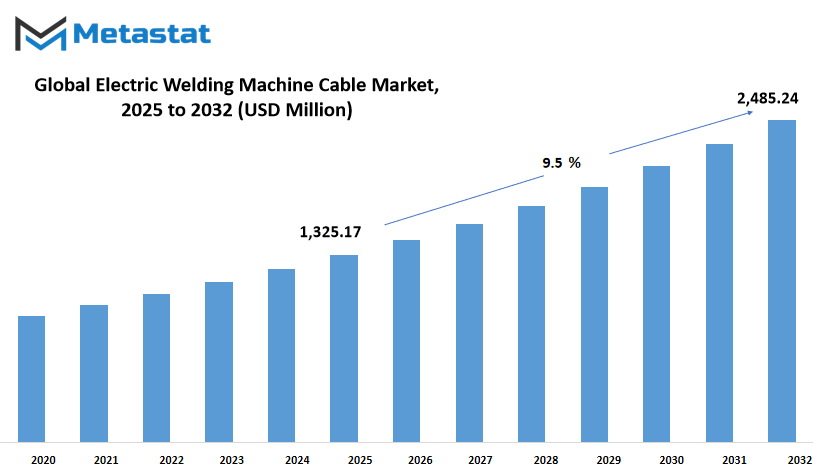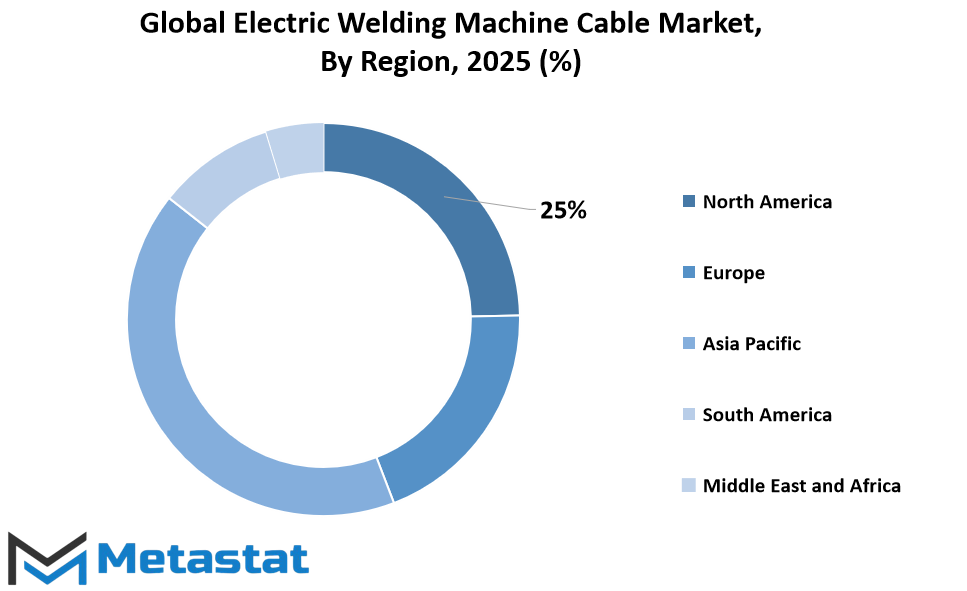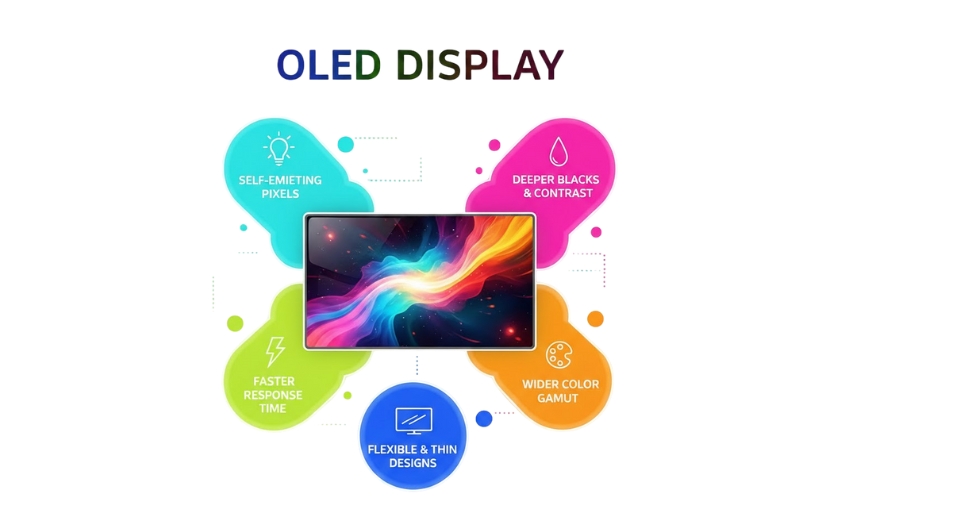MARKET OVERVIEW
The global electric welding machine cable market is on the verge of embodying a more complex change in the larger industrial machinery and equipment sector than statistics or trends can report. This market, though based in the physical use of cables to conduct electric currents to welding machines, will start to embody wider meanings technologically, economically, and operationally. As automation takes a deeper hold throughout manufacturing centers and remote maintenance becomes an emerging norm, the cables that are at the core of welding processes will become increasingly relevant, transcending their existing mechanical purposes into more active, networked responsibilities.
In the future, expectations for electric welding machine cables will cease to be solely based on conventional durability or performance. They will be expected to provide consistent conductivity under increasingly stressful conditions, as they evolve to accommodate the increasing integration of smart control systems and sensors into industrial devices. In the coming times, the global electric welding machine cable market will not only cater to static assembly lines' needs but will spread into mobile use, offshore installations, and field-based fabrication jobs where flexibility, stability of signals, and safety measures will dictate quality standards. These transformations will reshape the environment in which these cables function and determine how manufacturers come up with, test, and implement them.
As industries step closer to data-intensive ecosystems, welding processes, previously regarded as stand-alone physical activities, will be transformed into data-enriched processes. This development will fuel a fresh wave of demand in the electric welding machine cable market. Cables are likely to start carrying embedded functions like real-time diagnostics or resistance tracking with predictive maintenance benefits and low downtimes. Such features will make a erstwhile less perceptible component a proactive asset in the manufacturing process.
The global electric welding machine cable market will also start to overlap with wider debates around resource efficiency and the environment. As industries will need to implement sustainable processes not just for regulatory purposes but as an expectation of the market, the manufacturing of cables will see a change in the materials used and the techniques followed. Insulation and conductor technologies can focus on recyclability and a lower ecological footprint. But achieving these changing expectations will not water down the need for toughness and resilience; instead, it will challenge innovation in how both these qualities can coexist.
International trade dynamics will have an underplayed but significant part to play in determining the way that this market develops. Nations which presently import significant quantities of electric welding cables can turn towards domestic production, not only to minimize reliance, but to develop strategic industrial independence. Cable manufacturers in these circumstances might be required to expand their production bases or create alliances in territories previously beyond their reach.
In essence, the global electric welding machine cable market will move beyond its present limits. What will seem like an electrical performance-defined segment will slowly become one infused with intelligence, flexibility, and sustainability. Its function will no longer be peripheral but central to discussions about automation, efficiency, and innovation in industry as a whole. Therefore, the years ahead will require a rethink of both product and purpose in the industry as a whole.
Global electric welding machine cable market is estimated to reach $2,485.24 Million by 2032; growing at a CAGR of 9.5% from 2025 to 2032.

GROWTH FACTORS
The global electric welding machine cable market is an increasing number of attracting interest as sectors inclusive of construction, automobile, and delivery preserve developing. These sectors are depending on robust and dependable welding activities, and cables are at the vanguard in making sure overall performance and reliability. With infrastructure projects proliferating in the rising markets, specially in Asia-Pacific and Latin America, call for for dependable welding cables increases. Fabrication operations have elevated each inside the public and the personal sectors, and this pace is anticipated to keep, fueling the call for for first-class welding equipment and components.
Although the marketplace is promising in growth, it is now not with out its own share of demanding situations. Among the maximum obvious problems is the volatility of raw cloth costs. Copper and rubber, which can be normally applied in welding cables, generally tend to look rate fluctuations based totally on global supply and demand. These unstable charges can wreak havoc on production budgets and have an impact on product pricing. Moreover, welding cables are subjected to harsh conditions baked by using excessive temperatures, rubbed away via abrasion, and strained with the aid of mechanical strain. This has a tendency to motive abrasion and put on, requiring steady protection or alternative, which could drive up operational costs and motive downtime.
In spite of these kinds of concerns, future boom is being led through innovation. Companies are making an investment in designing cables that aren't handiest more immune to heat but also lighter in weight and more potent. These technological improvements are set to reduce renovation necessities at the same time as improving normal performance. The enterprise is likewise witnessing interest in substances that lengthen cable life with out compromising on flexibility or conductivity.
Going forward, the emphasis will be on sustainability and efficiency. With industries competing to reduce energy use and increase productivity, improved cable technology will be crucial. This transition, coupled with increased industrial activities in emerging economies, will maintain the momentum intact. The global electric welding machine cable market, as envisioned by Metastat Insight, is at a promising level driven by demand and pulled by innovation, even while it addresses price and endurance issues.
MARKET SEGMENTATION
By Type
The global electric welding machine cable market is progressing steadily towards further specialization, with various types of machines defining the need for special cable solutions. Manual welding machines represent one of the salient segments, currently at a value of $620.45 million. The machines are still important in small industries and workshops where flexibility and control for operators are essential. While manual systems can appear simple in comparison with more modern options, their low maintenance and reliability guarantee that they are a popular option for an extensive user base.
Automatic welding equipment, however, is increasingly being adopted by broader industrial environments. Automatic welding equipment is employed where precision, accuracy, and efficiency are required. Cables applied in this segment are made of stronger materials to endure lengthy use and more electrical load. With constant upgradation of processes by manufacturers, the sector should continue to improve, buoyed by improved automation and robotics technology designed to enhance efficiency while keeping costs down.
Semi-automatic welding machines are intermediate between the two, providing a combination of control and automation. It is most favored in operations that demand high cost versus performance balance. Cables in this category are positioned to provide both high flexibility and durability requirements, supporting variable use without losing safety features.
The division of welding machines into manual, automatic, and semi-automatic emphasizes the diversity of user requirements that continues to drive the global electric welding machine cable market. Each category requires unique technical specifications, which challenge manufacturers to innovate and enhance their products. As sectors like automobile, construction, and manufacturing grow, the need for specialized welding tools and the cables that enable them will continue to increase.
By Cable Length
The global electric welding machine cable market, if analyzed in terms of cable length, is segmented into three segments: short length cables, medium length cables, and long length cables. Each segment has a crucial role to play in catering to the specific requirements of various welding applications in various industries.
Short cables are generally preferred where the welding machine and the workpiece are close to each other. Such cables are convenient and efficient for use in small workspaces and reduce cable congestion for easier operations. They are widely used in workshops, car repair departments, and small fabrication yards. Even though they are not for long distances, they are very conductive and flexible, and thus they are a good option for high-precision applications.
Medium cable lengths typically fall in the middle ground between reach and tractability. Most commonly used in settings where operators require a little extra room to move without losing performance, these lengths see heavy usage in construction zones and industrial facilities of medium size. This length acts as the middle child, balancing maneuverability and consistent power flow. The versatility of medium length cables in accommodating different working environments has made them a favorite among professionals who would prefer their equipment to be as versatile as possible.
Long cables, however, are needed in mass operations where distance is crucial. They are mostly applied in shipyards, heavy machinery production, and outdoor maintenance work where the welding machine has to be set away from the workspace. Although they need more cautious handling since they weigh more and there is energy loss over longer distances, advances in cable technology have ensured efficiency even at longer cables.
This division in the global electric welding machine cable market is a reflection of real-world user requirements and the environment in which they operate. As industries keep evolving and growing, every category of cable length will also find its niche, providing custom solutions to suit particular operating needs. Whether to allow for precision, flexibility, or greater reach, the availability of short, medium, and long cables is such that the market will always be able to meet the evolving requirements of welding professionals.
By Cable Material
The global electric welding machine cable market continues to demonstrate substantial growth, driven by sustained industrial activity and the continued growth of automation. A prominent category of this market is the division based on cable material, in which the market further splits into copper welding cables and aluminum welding cables. This category is a key factor in determining manufacturing choices and pricing policies.
Copper welding cables are also common because of their flexibility and high conductivity, which makes them a favorite in most working environments. The fact that they can handle more current without getting hot also explains why they are well liked. Although they are heavier and costlier, this has made some manufacturers and consumers look elsewhere. Conversely, aluminum welding cables, while slightly less conductive, provide a lighter and less expensive alternative. This makes them ideal for applications where cost and weight are concern, even though they might have to use slightly thicker insulation or larger size to do equally well.
The choice between the two depends on a number of practical factors, including the size of the welding work, working conditions in which the cable is employed, and overall operating expense. Large-scale production industries or infrastructure sectors may favor the use of aluminum because of its cost-effectiveness, while performance-oriented industries may stick to copper cables. The market will keep on reacting to evolving user needs, cost pressures, and changes in industry standards, defining the way each material is embraced.
As companies seek alternatives to boost efficiency and reduce costs without compromising on safety or quality, the disparity between copper and aluminum welding cables will continue to be at the core of buying decisions. Ongoing improvements in cable insulation design and technology mean that both materials will continue to be relevant, albeit possibly with changing roles according to supply and changing user demands, respectively.
By Application
The global electric welding machine cable market is increasingly growing with industries still investing in more advanced infrastructure. Categorically, one of the primary ways this market is segmented is by application namely over industrial, commercial, and residential applications. All three segments have a distinct role in creating demand and impacting the types of cables that are manufactured.
Industrial application is where welding machine cables form the backbone of day-to-day operations. Factories, works, and high-volume workshops depend on these cables for steady, high-power welding operations. These conditions require cables that can withstand durability and long life, usually under heavy working conditions. As industries become more automation-oriented and safety-oriented, the demand for dependable and heat-resistance cables will rise further. Industrial applications thus not only represent high-volume requirements but also fuel ingenuity in material resilience and cable construction.
Commercial utilization is a completely unique angle available on the global electric welding machine cable market. Companies together with construction businesses, restore shops, and infrastructure firms have a tendency to perform in converting environments. They need cables that are not most effective long lasting however additionally bendy and handy to carry. Commercial jobs have a tendency to be different in length and location, so the cables want to be conditioned to deal with varying voltages and welding strategies. This industry has excessive boom potential, in particular as small and medium corporations develop their capacity and reach.
At the residential stage, the demand would possibly appear smaller in terms of scale but remains massive. Do-it-yourself welding tasks and home-primarily based workshops have become increasingly regularly occurring. Individuals assignment private projects or domestic maintenance want light-weight, less costly cables which can be handy to deal with and save. As a end result of extended hobbyist culture and small-scale repair sports, this segment is predicted to stay regular in call for.
In total, segmenting the global electric welding machine cable market by application industrial, commercial, and residential use paints a better picture of how widespread and useful the demand is. From factories to garage workshops, every region plays its part in defining the needs and aspirations from cable producers. As usage and innovation expand further, every segment will have a role in driving the market.
|
Forecast Period |
2025-2032 |
|
Market Size in 2025 |
$1,325.17 million |
|
Market Size by 2032 |
$2,485.24 million |
|
Growth Rate from 2025 to 2032 |
9.5% |
|
Base Year |
2024 |
|
Regions Covered |
North America, Europe, Asia-Pacific Green, South America, Middle East & Africa |
REGIONAL ANALYSIS
The global electric welding machine cable market is unfold throughout extraordinary regions, each of which has a selected function in determining its future. The areas are North America, Europe, Asia-Pacific, South America, and the Middle East & Africa. Each region has some thing special to provide within the form of producing, consumption, in addition to technological improvement. North America has the USA, Canada, and Mexico as its components, wherein the U.S. Leads the price in innovation and infrastructure. Canada and Mexico complement the region with stable demand and changing commercial configurations, contributing to the marketplace's basic push.
Europe consists of countries consisting of the UK, Germany, France, and Italy, among other regions of the continent. Europe is blessed with a robust commercial base, in which Germany, in precise, stays an critical contributor based totally on its engineering prowess and hooked up manufacturing recognition. The UK, France, and Italy upload based on their growing production and electricity sectors, whilst the relaxation of Europe drives the growth with extra diminutive however strong demand pockets.
Asia-Pacific consists of India, China, Japan, South Korea, and the encompassing location. China and India, with their expanding business operations and infrastructure improvement, are the principle participants. China's heavy-responsibility production and India's multiplied hobby in renewable energy and creation have installed a robust market situation. Japan and South Korea, with their excessive technology and emphasis on automation, propel the want for efficient and dependable welding equipment. The rest of the Asia-Pacific nations also indicate increasing potential, particularly in emerging industrial regions.
South America, led by Brazil and Argentina, features a developing market with sustained gains in demand through urbanization and industrialization. These nations, as well as the remainder of South America, indicate potential since they continue to develop and modernize their infrastructure. At the same time, the Middle East & Africa region comprises GCC Countries, Egypt, South Africa, and other surrounding regions. This region, particularly the GCC nations, is experiencing increased investment in oil, gas, and construction, which frequently demand high-performance and durable welding machine cables. Egypt and South Africa are contributing with their continuing industrialization, and the remainder of the region is catching up, taking new market opportunities with it.
The various geographical regions make up the foundation of the structure of the market. Each has its own rate and agenda, but all are heading toward more efficient, consistent, and sophisticated solutions in the electric welding machine cable industry.

COMPETITIVE PLAYERS
The global electric welding machine cable market, as supplied through insights via Metastat Insight, displays a area formed by way of each innovation and steady industrial call for. These cables, important for transmitting high electric currents safely, shape a foundational part of welding setups across production and production landscapes. As industries continue to prioritize sturdiness, safety, and electricity performance, the need for excessive-overall performance welding cables will stay sizeable. They aren’t just add-ons they’re important tools that make certain the seamless float of electricity for the duration of welding operations.
In recent years, technological improvements have driven manufacturers to create cables which can be extra warmth-resistant, flexible, and lengthy-lasting. This pass isn't always pretty much better satisfactory; it is also a response to actual-global demanding situations faced with the aid of employees using these tools every day. Many of the adjustments happening in this market are grounded in person remarks and fingers-on experience, not simply lab checks. As greater companies across sectors like automotive, heavy equipment, and construction depend on automation and advanced welding approaches, the call for reliable cables will develop thus.
Among the properly-recognized names shaping this enterprise are Wilhelmsen, Prysmian Group, Nexans, Lapp Group, HELUKABEL, Weihai Honglin Electronic, Xinlan Group, Hebei Huatong Wires and Cables Group, and HeBei Donggang Cable. These corporations no longer most effective compete on great and fee but are also contributing to sustainability and strength-saving efforts with the aid of designing products that decrease energy loss for the duration of transmission. As environmental worries increase, producers are being called upon to ensure their products meet stricter compliance and overall performance standards.
This marketplace is likewise being motivated via shifts in international infrastructure tasks, which often require reliable welding equipment in huge volumes. As countries invest in building and repairing transportation systems, power vegetation, and production hubs, demand for these cables is expected to stay strong. Moreover, the rising recognition of electric cars and smart manufacturing strategies has extended the welding cable’s position beyond conventional packages.
While opportunities are present, opposition stays stiff, and groups need to continue to evolve to moving expectancies in terms of excellent, pricing, and deliver chain performance. Those who stay ahead will probable be the ones that not simplest innovate but additionally maintain a near reference to the those who use their merchandise every day.
In summary, the global electric welding machine cable market is firmly rooted in real-global commercial wishes, with key gamers like Wilhelmsen, Prysmian Group, Nexans, and others driving product development and market path. Looking ahead, the combination of sensible demand, technological updates, and sustainability goals will form how this enterprise moves in advance.
Electric Welding Machine Cable Market Key Segments:
By Type
- Manual Welding Machines
- Automatic Welding Machines
- Semi-Automatic Welding Machines
By Cable Length
- Short Length Cables
- Medium Length Cables
- Long Length Cables
By Cable Material
- Copper Welding Cables
- Aluminum Welding Cables
By Application
- Industrial Applications
- Commercial Applications
- Residential Applications
Key Global Electric Welding Machine Cable Industry Players
- Wilhelmsen
- Prysmian Group
- Nexans
- Lapp Group
- HELUKABEL
- Weihai Honglin Electronic
- Xinlan Group
- Hebei Huatong Wires and Cables Group
- HeBei Donggang Cable
WHAT REPORT PROVIDES
- Full in-depth analysis of the parent Industry
- Important changes in market and its dynamics
- Segmentation details of the market
- Former, on-going, and projected market analysis in terms of volume and value
- Assessment of niche industry developments
- Market share analysis
- Key strategies of major players
- Emerging segments and regional growth potential








 US: +1 3023308252
US: +1 3023308252






